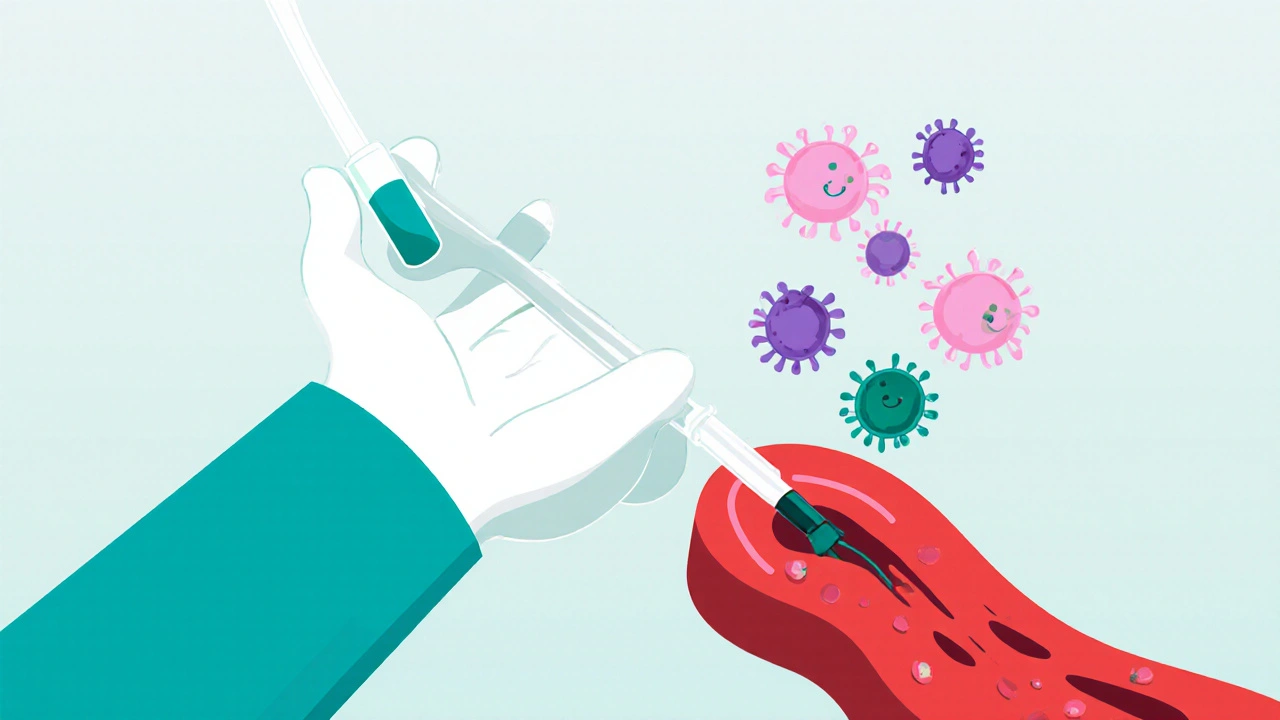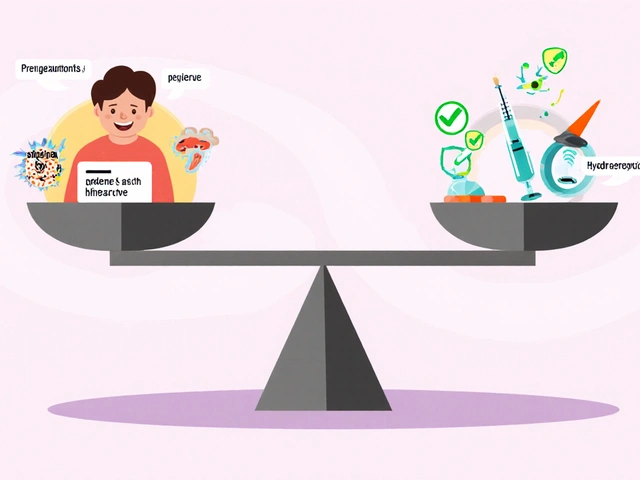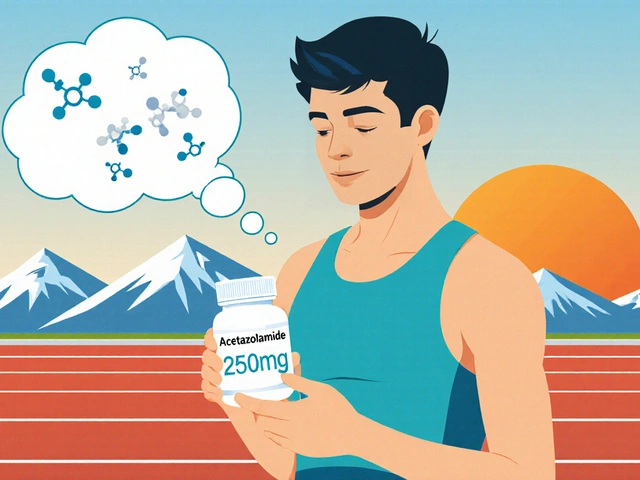Candidemia Risk Assessment Tool
Your Candidemia Risk Assessment
This tool helps you understand your risk of developing candidemia based on key factors. Remember, this is for educational purposes only and should not replace professional medical advice.
When a yeast gets into the bloodstream, Candidemia is the medical name for that serious infection. If the fungus spreads beyond the blood to organs such as the kidneys, liver, or eyes, doctors call it a Disseminated Candida infection. These conditions are rare but life‑threatening, and the best way to keep them from happening is simple: educate patients about the risks, early signs, and what to do when they appear.
What Exactly Is Candidemia?
Candidemia occurs when Candida species, most often Candida albicans, breach the skin or mucosal barriers and enter the bloodstream. Once there, the yeast can travel to distant sites, turning a bloodstream infection into a Disseminated Candida infection. The infection can develop within days of a catheter insertion, abdominal surgery, or a prolonged course of broad‑spectrum antibiotics.
How Do These Infections Spread?
The most common routes are:
- Central venous catheters that provide a direct pathway into the blood.
- Intestinal translocation - a leaky gut lets yeast cross into the bloodstream.
- Urinary or respiratory catheters that become colonized with Candida.
Even everyday activities can be a trigger for high‑risk patients. For example, oral thrush that isn’t treated can seed the bloodstream during dental procedures.
Who Is Most at Risk?
Understanding risk factors helps patients stay vigilant. The biggest predictors are:
- Immunocompromised host - chemotherapy, transplant drugs, HIV, or steroids.
- Recent major surgery, especially abdominal or cardiac.
- Prolonged intensive‑care unit (ICU) stay.
- Broad‑spectrum antibiotic use that wipes out normal bacterial flora.
- Presence of an indwelling catheter for more than 48 hours.
Early Signs & Symptoms to Watch For
Because the infection can progress fast, patients should know the red flags:
- Fever that doesn’t respond to regular antibiotics.
- Chills, sweats, or feeling unusually cold.
- Rapid heart rate or low blood pressure.
- Sudden pain in the abdomen, back, or joints.
- Visual disturbances or eye pain - a sign the fungus may have reached the eye.
If any of these appear, a doctor should be called immediately.
How Is Candidemia Diagnosed?
The gold standard is a blood culture. Labs typically need 48‑72 hours to grow Candida, but newer rapid PCR tests can give results in under 12 hours. Imaging (CT or MRI) may be ordered if organ involvement is suspected, and a fundoscopic eye exam checks for ocular lesions.
Antifungal Treatment Options
Choosing the right drug depends on the species, severity, and patient kidney or liver function. Below is a quick comparison of the most common agents.
| Drug Class | Typical Agent | Route | Key Advantage | Common Side‑Effect |
|---|---|---|---|---|
| Azoles | Fluconazole | IV or PO | Good oral bioavailability | Liver enzyme elevation |
| Echinocandins | Caspofungin | IV only | Effective against azole‑resistant strains | Infusion‑related fever |
| Polyenes | Amphotericin B | IV only | Broadest spectrum | Nephrotoxicity |
Guidelines recommend starting with an echinocandin for critically ill patients, then de‑escalating to fluconazole if the isolate is susceptible. Treatment typically lasts 14 days after blood cultures turn negative, but longer courses are needed if organs are involved.
Why Patient Education Saves Lives
Patients who understand their risk are more likely to:
- Report fevers early, prompting faster labs.
- Demand removal of unnecessary catheters.
- Adhere to long‑term oral antifungal regimens.
- Watch for late complications, such as eye infections.
Studies from 2022‑2024 show that education programs cut candidemia mortality by up to 30 % in ICU settings.
Practical Tips for Patients and Caregivers
- Know your lines. Keep a list of all IV catheters, urinary catheters, and feeding tubes. Ask the nurse when they can be removed.
- Track fevers. Use a digital thermometer and note any temperature above 38 °C that lasts longer than 24 hours.
- Stay on schedule. If you’re prescribed fluconazole or another oral drug, set an alarm. Missed doses can allow yeast to rebound.
- Maintain oral hygiene. Brush twice daily and use an antifungal mouthwash if you develop thrush.
- Ask about labs. If you’re high‑risk, request a baseline blood culture before surgery or chemotherapy.
When to Call a Doctor or Go to the Emergency Room
Don’t wait for a scheduled appointment if any of these occur:
- Fever > 38 °C that doesn’t improve after 24 hours of antibiotics.
- Sudden dizziness, rapid breathing, or a drop in blood pressure.
- New pain in the abdomen, back, or joints.
- Changes in vision, such as blurriness or eye pain.
Prompt medical attention can mean the difference between a short hospital stay and a life‑threatening septic episode.
Frequently Asked Questions
Can Candida infections be prevented?
Yes. Good hand hygiene, early removal of catheters, limiting broad‑spectrum antibiotics, and keeping blood sugar under control all lower the risk.
How long does treatment usually last?
For uncomplicated candidemia, 14 days after the last positive blood culture is typical. If organs are infected, therapy may extend to 4-6 weeks.
Is fluconazole safe for kidney patients?
Fluconazole is primarily cleared by the kidneys, so dose adjustment is required in renal impairment, but it’s generally safe when monitored.
What’s the difference between candidemia and a Candida skin infection?
A skin infection stays on the surface and rarely spreads. Candidemia means the fungus is in the bloodstream and can travel to vital organs, making it far more serious.
Can I develop candidemia after a short course of antibiotics?
It’s uncommon, but prolonged or high‑dose broad‑spectrum antibiotics can disrupt normal flora enough to allow Candida to overgrow and enter the bloodstream.



 Medications
Medications





Kimberly Lloyd
October 21, 2025 AT 00:11Embrace knowledge and stay hopeful about managing candidemia risks.
Lolita Gaela
October 23, 2025 AT 07:45The pathogenesis of candidemia involves translocation of Candida spp. across compromised mucosal barriers, often facilitated by broad‑spectrum antimicrobials that disrupt the bacterial microbiota. Central venous catheters serve as a nidus for biofilm formation, which markedly reduces antifungal penetration. Early detection hinges on serial blood cultures and the utilization of rapid PCR assays, which can truncate diagnostic latency to under 12 hours.
Giusto Madison
October 25, 2025 AT 15:18Look, the data aren’t rocket science-if you have a line in place for more than 48 hours, you’re already flirting with infection. Keep a tight log of your catheters and call the team the instant your temp spikes. It’s the fastest way to slash mortality.
Sakib Shaikh
October 27, 2025 AT 21:51Yo bro, listen up! The fungal ninjas are creepin’ in through those tubes and you’re thinkin’ it’s just a little ache? Nah, that’s a full‑blown invasion-your kidneys, eyes, the whole crew can get hit if you don’t act ASAP!!!
Chirag Muthoo
October 30, 2025 AT 05:25It is incumbent upon the healthcare practitioner to convey to the patient, in an unambiguous manner, the imperative of vigilant monitoring of febrile episodes and the expeditious removal of indwelling catheters when clinically feasible. Such diligence is demonstrably correlated with a reduction in candidemic morbidity.
erica fenty
November 1, 2025 AT 12:58Wow, great article-so many crucial points!-especially the part about tracking fevers, documenting lines, and adhering to treatment schedules. Keep it up, folks!!!
Xavier Lusky
November 3, 2025 AT 20:31Don't trust the pharma-they don't want you to know how easy it is to slip into a bloodstream infection while you think you’re just taking a pill.
Ashok Kumar
November 6, 2025 AT 04:05Sure, all that high‑falutin jargon sounds impressive, but at the bedside we just need a clear message: get the lines out early and run the cultures fast. Anything else is just fluff.
Jasmina Redzepovic
November 8, 2025 AT 11:38Our nation’s hospitals must prioritize patient education above all else; otherwise we’re surrendering to a global health threat that undermines our sovereignty. Knowledge is the strongest defense!
Esther Olabisi
November 10, 2025 AT 19:11Totally agree! 🙌 Let’s spread the word and empower every patient-no more silent battles! 💪
Ivan Laney
November 13, 2025 AT 02:45Education on candidemia is not a luxury; it is a national imperative that safeguards our citizens from a stealthy killer. When patients understand the pathways of infection, they become active participants in preventing bloodstream invasion. Every catheter line should be scrutinized, and any unnecessary device removed without delay. Early fever detection empowers clinicians to order blood cultures before the fungus takes hold. Rapid PCR diagnostics cut the window of uncertainty, allowing prompt antifungal initiation. Without vigilant monitoring, the pathogen can disseminate to vital organs, leading to irreversible damage. Hospitals that invest in structured patient education see mortality rates plummet by up to thirty percent. This is a testament to the power of informed vigilance in clinical practice. Policymakers should allocate resources to develop multilingual pamphlets and bedside counseling sessions. The cost of these programs is dwarfed by the savings from reduced ICU stays and complex surgeries. Moreover, educating caregivers ensures adherence to prolonged oral antifungal regimens, which is crucial for eradication. The collective effort of nurses, physicians, and patients forms a bulwark against this opportunistic foe. Ignoring education is tantamount to abandoning our duty to protect public health. Let us champion comprehensive teaching initiatives across every healthcare facility. Only then can we truly claim to defend the health of the nation.
Angela Koulouris
November 15, 2025 AT 10:18Your thorough outline paints a vivid picture of how education can turn the tide-well said.
Harry Bhullar
November 17, 2025 AT 17:51From a clinical standpoint, the integration of patient‑centered educational modules has been shown to streamline early detection protocols. By teaching patients to log temperature spikes and recognize catheter‑related discomfort, we effectively create a shared surveillance system. This collaborative approach reduces the lag between symptom onset and diagnostic workup, which is critical in sepsis‑prone environments. Additionally, reinforcing medication adherence through simple reminders-like phone alerts-mitigates the risk of sub‑therapeutic antifungal levels. Ultimately, empowering patients translates into measurable decreases in ICU length of stay and overall healthcare costs.
Dana Yonce
November 20, 2025 AT 01:25Great points! 😊